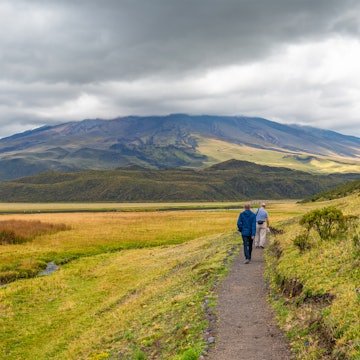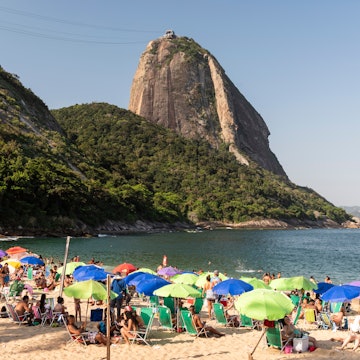

Plaza San Francisco and church of San Francisco at left.
This South American country may be small, but it has a dazzling array of wonders. Explore the colonial capital, Quito, before delving deep into the cloud forest, where hummingbirds flit and pumas stalk. Next, head high into the Andes and meet the indigenous craftspeople of Otavalo, then set out from Ibarra on a scenic train ride. End your adventure among the unique wildlife of the Galápagos.
This article appeared in the Fall 2017 issue of Lonely Planet magazine's U.S. edition.

Quito
The piercing blue light of a high-altitude dawn breaks over the old town of Quito, as dogs chase pickup trucks carrying produce to market. The trucks clatter over rambling streets cobbled with stones taken from the slopes of the Pichincha volcano looming above. Shopkeepers lift shutters, waving to one another as their wares are set out: sackfuls of cumin and cinnamon; aluminum pans; teetering piles of cows’ hooves; piñatas in the shapes of unicorns, Minnie Mouse and SpongeBob SquarePants.
Layers of commerce take place on these steep, narrow backstreets. In front of the shops, women in felt hats and woolen ponchos roll mats across sidewalks. From these they offer corn on the cob, potatoes and avocados grown in the villages they commute in from each day.
'All around us you can hear chismes,' says Paola Carrera, a guide to the San Roque neighborhood. 'This is our word for the secrets – the news and the gossip – shared by these vendors, brought to our capital from across Ecuador.' Carrera’s mother runs a shop selling agua de vida, the water of life. This intensely sweet tonic is made from 25 plants, including the amaranth flowers that give its bright pink color, and herbs from as far away as the Amazon forest.
'I’ve always enjoyed living here, above the shop,' Carrera says. 'The buildings in the neighborhood are so traditional; they have such character. The people who belong to San Roque have strong ties to it, and it has always drawn visitors.'

Like most locals who pass the nearby whitewashed church of San Francisco, Carrera makes the sign of the cross as she enters the church’s massive wooden doors; some also touch the sculptures of sun gods at its entrance, an action said to give energy.
The church’s foundation stone was laid in 1535, soon after Spanish conquistadors arrived from Andalucía. In a pragmatic move to win local support, Franciscan monks allowed religious symbols familiar to the indigenous Quitu people to blend with the Catholicism of the invading forces. The conquistadors also brought a Moorish architectural style from Islamic North Africa, and saw their wealth reflected in the spectacular gilding of the interior; for the people of Quito, the gold reflected the everlasting power of their sun god.
Walking farther into the neighborhood, Carrera introduces some of the artisans who inhabit the San Roque shops. Don Gonzalo Gallardo specializes in restoring religious effigies: he shows us a plastic baby Jesus singed in a house fire, and an armless plaster-of-Paris Virgin Mary accidentally knocked from a living room shrine. César Anchala runs Sombrerería Benalcázar, a hat shop established by his father some 65 years ago. He uses the same molds and irons to form the varied styles of trilby felt hats for sale. His is a diverse business, selling masks to be worn at festivals such as Inti Raymi, with origins that can be traced to the Incas who arrived in the 15th century. The masks depict mildly terrifying demons, plus a few Ecuadorian politicians.
In San Roque’s market, a line has formed outside Rosa Correa’s stall, despite the screams coming from within. A young couple emerges from behind a curtain, eyes agog. Like many of Correa’s clients, they pay $8 a week for a treatment aimed at removing stresses and influence from the 'evil eye.' Correa is a fourth-generation shaman who practices a technique that involves cheerfully whipping her clients with a succession of plants; her shelves are piled with chilies, marigolds, rose petals, mint and nettles. The old beliefs continue to run deep, and occasionally sting a little.

The Cloud Forest
Jungle music is playing 3900 feet up in the Chocó-Andean cloud forest. Rolling thunder sets the bassline. Pelting gobs of rain increase the rhythm, splashing against creepers, tree ferns and thick, languid arms of moss. The chirruping of insects hurtles wildly up and down in pitch and pace. And then, once the squelch of boots against red mud comes to a halt, the air fills with an unfamiliar whirring.
'White-whiskered hermit,' whispers guide José Napa. 'Violet-tailed sylph,' he says, more excitedly. 'Hmmm, brown Inca. Purple-bibbed whitetip! Empress brilliant!'
Napa is now surrounded by an emerald, ruby and sapphire blur of hummingbirds, together rising boldly from the mists to approach the feeder he has just topped up with sugar syrup. A pecking order is quickly established, literally with a nip to the head for a bee-sized green thorntail that tries to push before a larger cousin. 'They are so aggressive because they need to feed constantly,' Napa says. 'They have such a high metabolism, and the flowers they prefer to feed from can be surprisingly scarce in the forest.' One bird proves its eagerness by hovering within an inch or so of a floral pattern on a T-shirt, taking a close look on the off chance.

Alongside the Amazon, the Chocó is Ecuador’s other form of rainforest, watered by up to 20 feet of rainfall each year as clouds barrel off the Pacific and break against the lower slopes of the Andes. It is one of the dampest and most biodiverse environments on Earth, one threatened by the pollution of waterways, slash-and-burn farming and illegal logging.
Napa used to be a subsistence farmer, growing peanuts, cassava and bananas. He then joined the logging trade. Fourteen years ago a private lodge was built on the site of the local sawmill, so Napa came to work here instead. This became an eco-hotel, Mashpi, sitting in a 2900-acre wildlife reserve where once there was a logging concession. The reserve is set within a 42,000-acre buffer zone for sustainable development, aimed at offering animals the corridors to migrate between pockets of rainforest.
Napa has an intimate knowledge of the forest gained from having spent much of his life wandering through it. He predicts the clattering rush of a rufous-breasted wood quail by the slightest rustle of a leaf in the undergrowth. Then he reveals a glade beneath a fast-tumbling waterfall where fireflies like to gather at night.
He points to a fruit loved by Chocó toucans – one that makes them a little high – and a fungus known as dead man’s fingers, which can be snapped open to release an antibiotic ointment used by locals as a cure for infected eyes. At a vantage point looking across a valley, with mist hanging low, Napa makes a whooping call, and from far away comes the response. 'Howler monkeys,' he says.
Teams of scientists now are permanently based in Mashpi’s reserve, researching its numerous butterfly species, planning to reintroduce critically endangered brown-headed spider monkeys, and using camera traps to film the mammals that stay so well hidden in the dense forest. Some of the footage shows just how close a guest came to a rare encounter. First it reveals the man out for a casual morning stroll, minutes from the lodge. Unbeknownst to him, a predator’s eyes are watching – soon after, a large, inquisitive male puma stalks close behind.
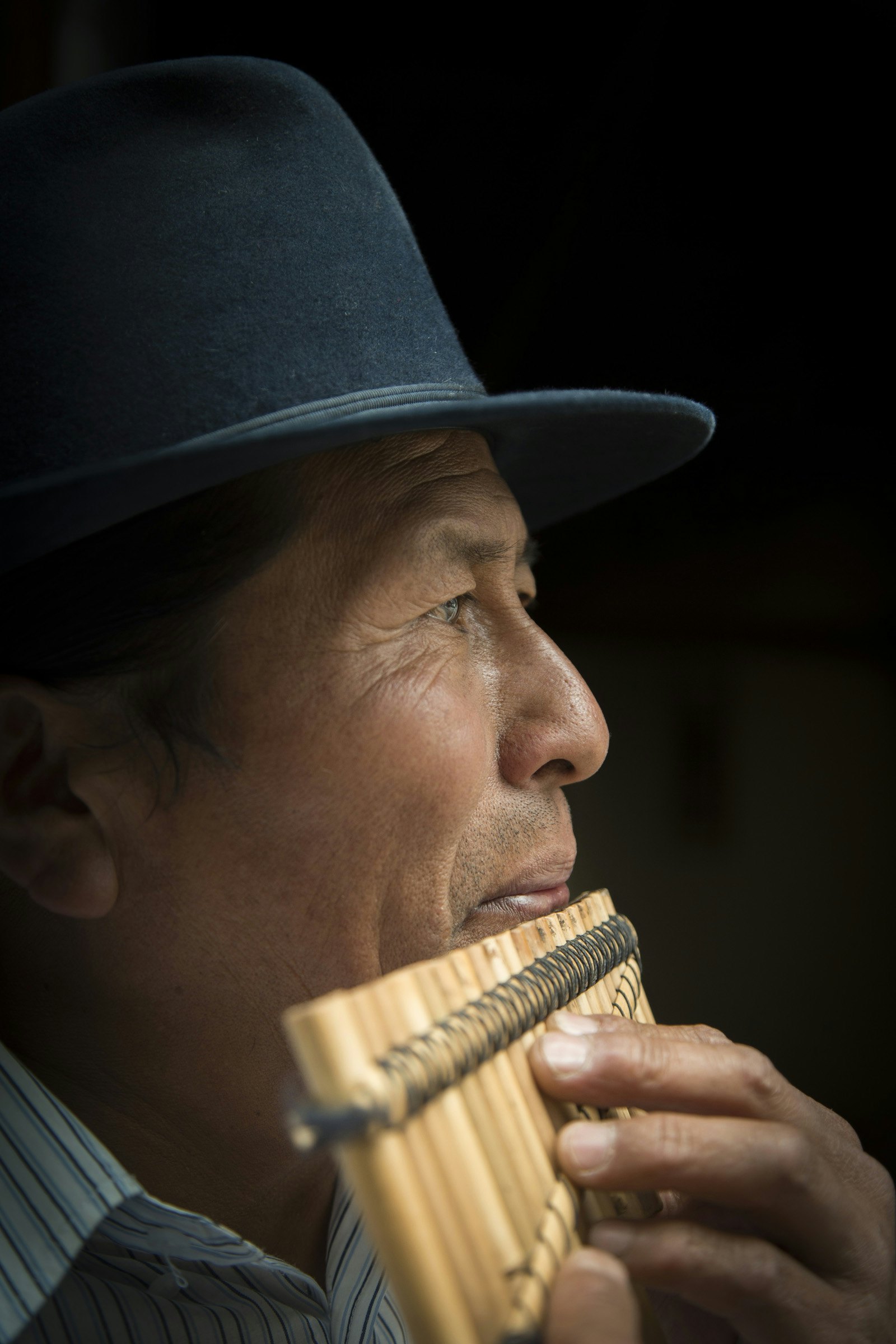
Otavalo
The road toward Otavalo bounces up into the Andes, past black pigs lolling in the dust and squat cows grazing on knee-deep grass. Fields of fava beans, lupines and corn are close to harvest, bordered by fiercely-spiked agave plants with their alien blooms sprouting skyward. Where the terrain becomes too steep for agriculture, pumas, spectacled bears and condors still live.
As in Quito, the markets of Otavalo are gathering points for inhabitants of the surrounding countryside. Mass today in the main church is being said in Kichwa, the indigenous language that evolved from the ancient tongue spoken by the Inca invaders – who then succumbed to the conquistadors. Outside, local Imbaya people are quietly searching for paying customers, the men mostly wearing tautly sculpted felt hats over a single long, plaited ponytail, and the women with necklaces of glass beads wrapped in gold leaf, their navy blue ponchos and white blouses exquisitely hand-embroidered with flowers.
The daily food market is filled with produce carted down from the fertile volcanic soils of the Andes: blackberries and tree tomatoes, plantains and alfalfa, all manner of corn and beans. In the market’s central corridor, lunch is beginning to be served. Locals savor steaming bowls of clams, chicken soup, black pudding mixed with popcorn, and hornado – whole roasted pig. Rosario Tabango proudly displays the certificate that declares her hornado the best in all Ecuador, presented by the country’s president. It is at turns crisp and chewy, and intense with salt, garlic and smoke from the wood it has been roasted over – gathered by Rosario on trips into the mountains.
Although Imbaya dress is mostly worn by stallholders in Otavalo’s handicrafts market, it is hard to find for sale here. Since pre–Columbian times, their forebears have precisely fed the demands of their consumers, and right now that means offering neon polyester ponchos, Che Guevara T-shirts and Bob Marley bobble hats to tourists who are briefly passing through.
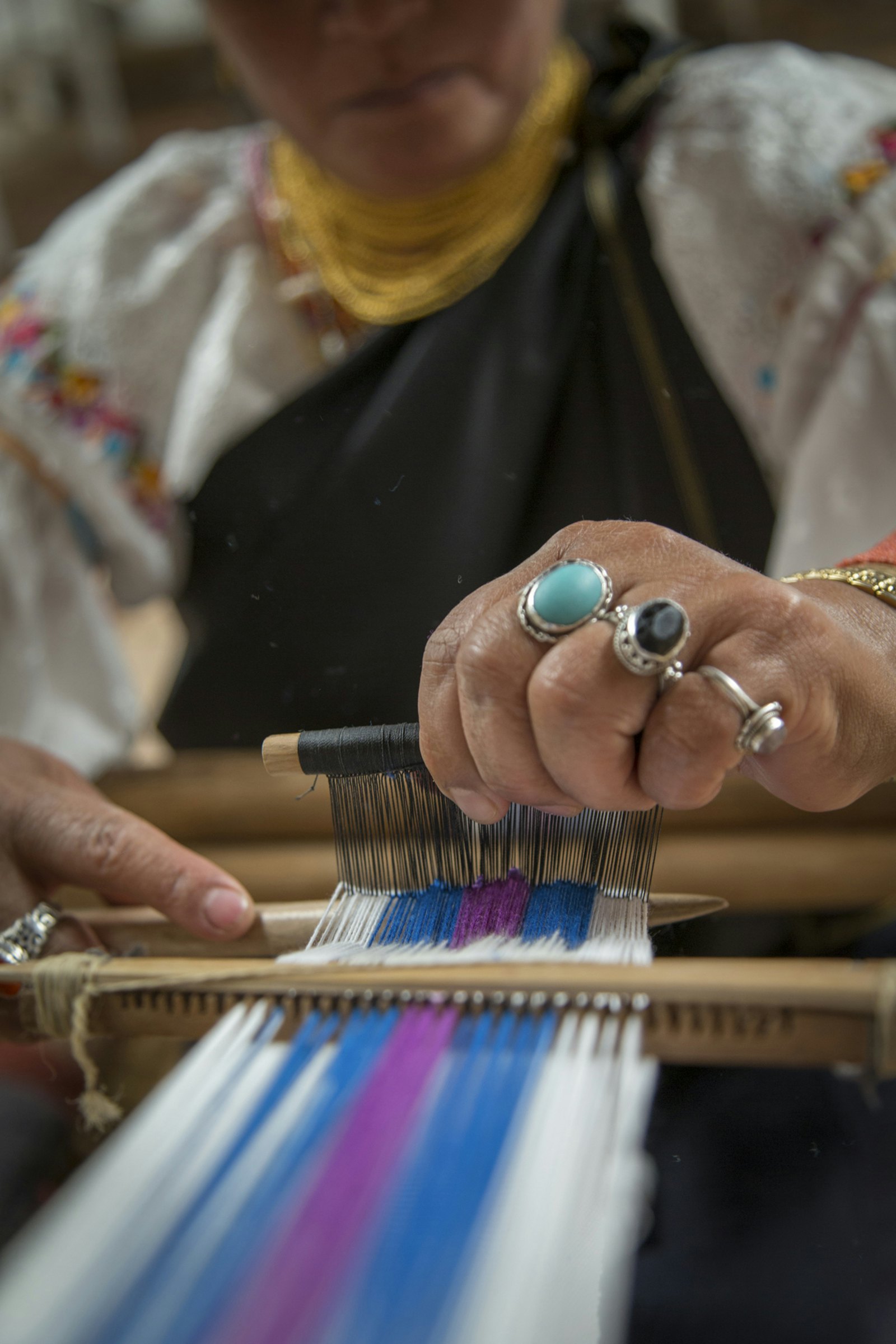
Traditional crafts are far better preserved in villages northeast of Otavalo. In Agato is a low stone workshop crammed with simple looms, baskets of alpaca wool and a hutch of squeaking guinea pigs. Inside, Luz Maria Andrango weaves a guagua chumbi – a 'baby belt' used to tighten an Imbaya woman’s blouse. It is colored with natural dyes made from red cochineal beetles, yellow lichen, indigo and rich, brown walnuts, and it will take her 10 days to finish.
In nearby Peguche is the flute workshop of José Luis Fichamba, established in 1969. 'I made my first pipes at the age of 10, and soon gave them to my friends so we could form a band,' he says. The son of a weaver and grandson of a musician, Fichamba still makes the paya (small panpipes), the rondador (larger panpipes that play two notes at once) and the gaita (a long wooden flute typical of Otavalo, most frequently played at the Inti Raymi festival).
As he offers a tune on a rondador, he says, 'When I play these, I feel a very special man – there are not too many people who play the rondador in Ecuador now. Once they were heard all over the Andes.' Fichamba’s music is exceptionally heartfelt, all the more softly beautiful for its village setting with snow-capped volcanoes beyond – and far removed from the tune most commonly played on panpipes in bars back in Quito: Abba’s 'Dancing Queen.'
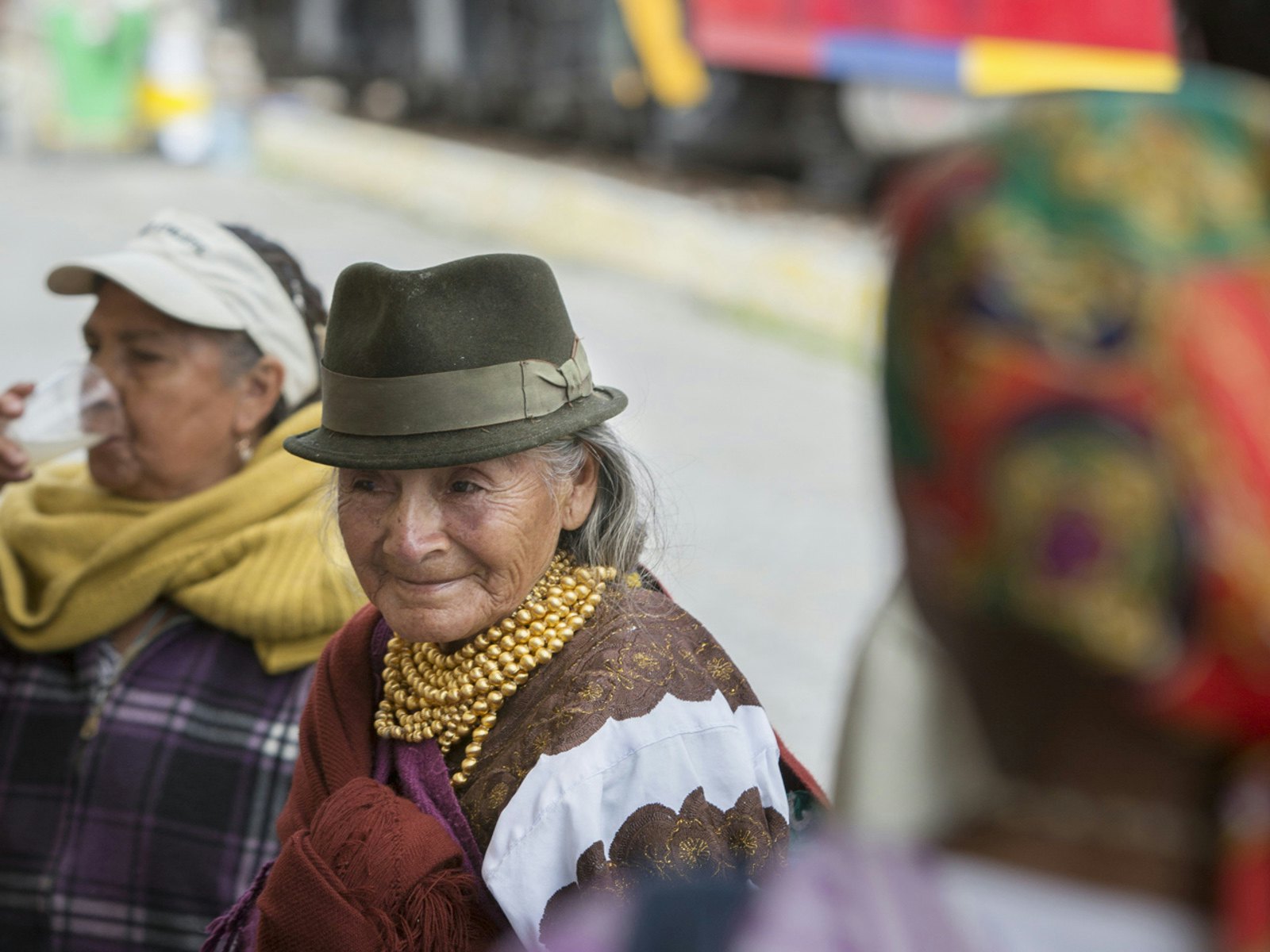
Ibarra
Hop on a train from a colonial mountain city to an Afro–Ecuadorian community set among sugarcane fields. Your route passes near – and sometimes through – volcanoes.
The Tren de la Libertad (Freedom Train) is in no hurry to leave. A team of brakemen uniformed in double denim check the two red carriages, preparing for a sharp descent through the Andes. The morning rush hour has never quite arrived in Ibarra, the largest city north of Quito. Wooden stools are set at the edge of the rails, coffees are shared, and papayas, newspapers and boiled sweets are hawked to the passengers who mill about nearby.
This former colonial mountain outpost has a troubled history. Imbabura volcano is said to be the sacred protector of the region, but an earthquake in 1868 devastated Ibarra. At the base of the volcano is Yahuarcocha lake – its name means 'lake of blood,' in memory of 30,000 indigenous Caranqui warriors killed here in the 15th century by forces of Incan emperor Huayna Capac.
Bells clonk and horns blare as a squall of activity erupts. Children are pulled from staring into the driver’s cabin, and bags are loaded. The departure ceremony becomes more dramatic with the arrival of two motorbike outriders, dressed like superheroes in coveralls and body armor. They ride ahead of the train for the first half of its route, grandly shooing livestock off the tracks and forcing trucks laden with sugarcane to halt at level crossings. The train slowly clanks through the suburbs, palms swaying overhead. Its journey is to be brief but scenic. Over the couple of hours required to cover 20 or so miles, the train enters five tunnels cut by hand in the early 20th century, and crosses two bridges spanning deep canyons. As the elevation drops from 7200 to 5200 feet, the route passes swamps, arid plains, forests of cacti and lonesome giant bromeliads, with the temperature rising from 59°F to 86°F.
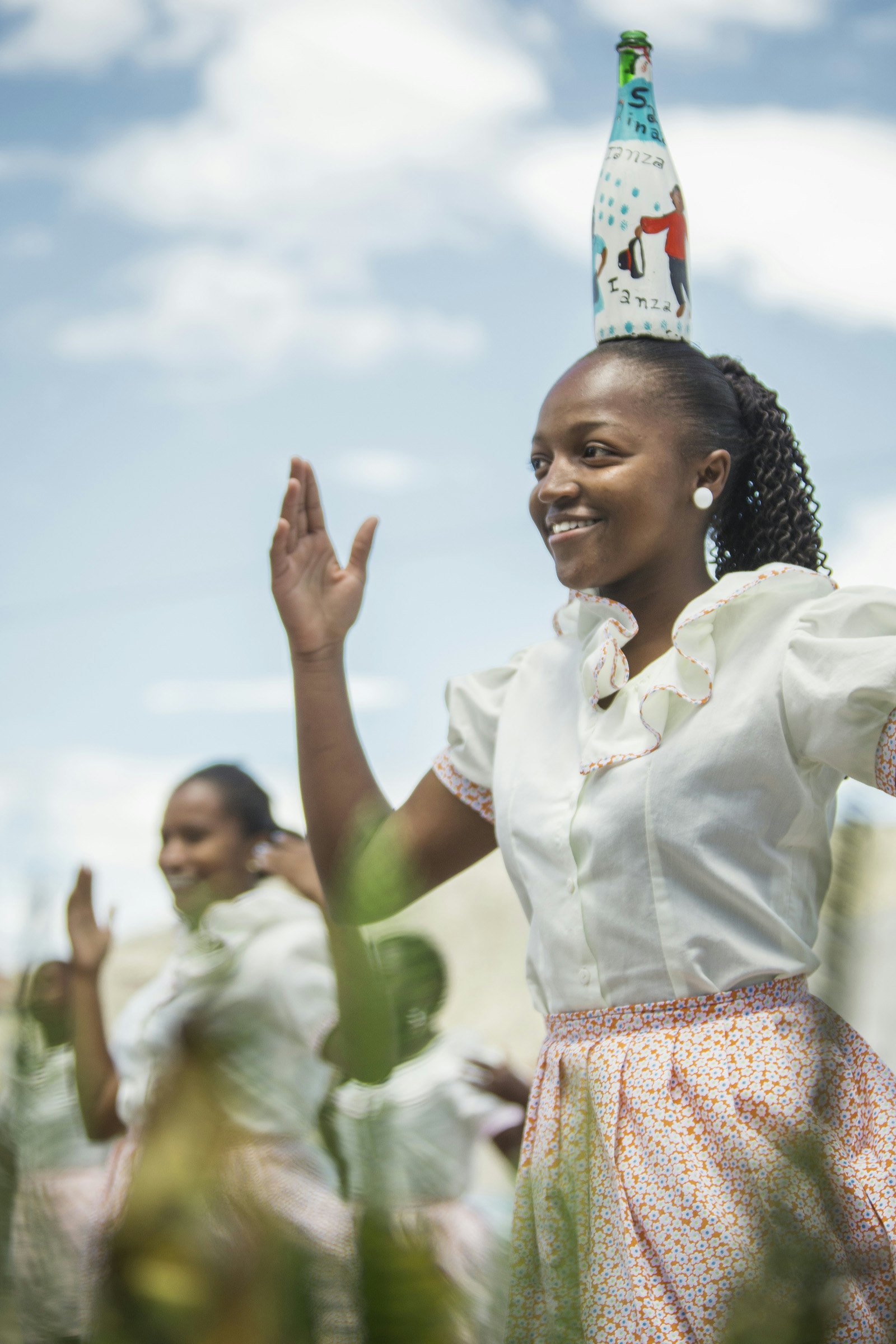
The train’s occupants roughly reflect Ecuador’s population: 3 percent Afro–Ecuadorian, 25 percent indigenous, and the majority, known as mestizos, with a mix of Spanish and indigenous ancestry. The route levels out and the train passes through horizon-to-horizon fields of sugarcane, grown here since Jesuit priests first established sprawling haciendas in the 16th century, not long after the arrival of the conquistadors. The Jesuits soon realized that slaves from Africa could be forced to gather the cane more efficiently than the often smaller indigenous workers. The name of today’s train service recognizes the liberty finally given to those slaves in the mid-19th century.
Milena Espinoza is a descendant of slaves who chose to remain in the quiet town of Salinas, the farthest point on the train’s route. She and her friends perform a bomba dance for disembarking passengers, one traditional to Afro–Ecuadorians; it’s party music with an easy rhythm. 'I would dance bomba all the time if I could,' she says. 'We are glad to rescue the old traditions. These cotton petticoats are like maids once would have worn, and we dance with bottles on our heads as our ancestors would have – they kept them there to prevent the slave owners from taking their alcohol.' When asked what the song’s lyrics mean, Espinoza says: 'They are always the same. They say this woman is black and happy. She makes these movements, then gives a kiss to her friends.'

The Galápagos
Beneath the rich glow of a tropical sunset, a group of taxi drivers face off in a volleyball game. Little kids shriek with excitement and popcorn is eaten in immense quantities, as some unusual visitors join the cheering crowd. A Galápagos sea lion nudges its way onto a bench by the harborside of Puerto Ayora, draping its flippers over the edge and pretending to sleep – one eye open in search of a snack. From a fast-rising tide pours a horde of Sally Lightfoot crabs, their scarlet claws probing the rocks for food. They are joined by marine iguanas, with snouts wrinkling as they sneeze out the salt absorbed during dives for seaweed.
The Galápagos were known as Las Islas Encantadas – The Enchanted Islands – by the first explorers to arrive here in the 16th century, and certain myths about them endure. Not everyone realizes that this archipelago of 19 islands is part of Ecuador, the country’s mainland lying 600 miles across the Pacific. And although the often unique and strangely bold wildlife captures all attention, a human population of 30,000 lives alongside – half in the town of Puerto Ayora, on the central island of Santa Cruz.
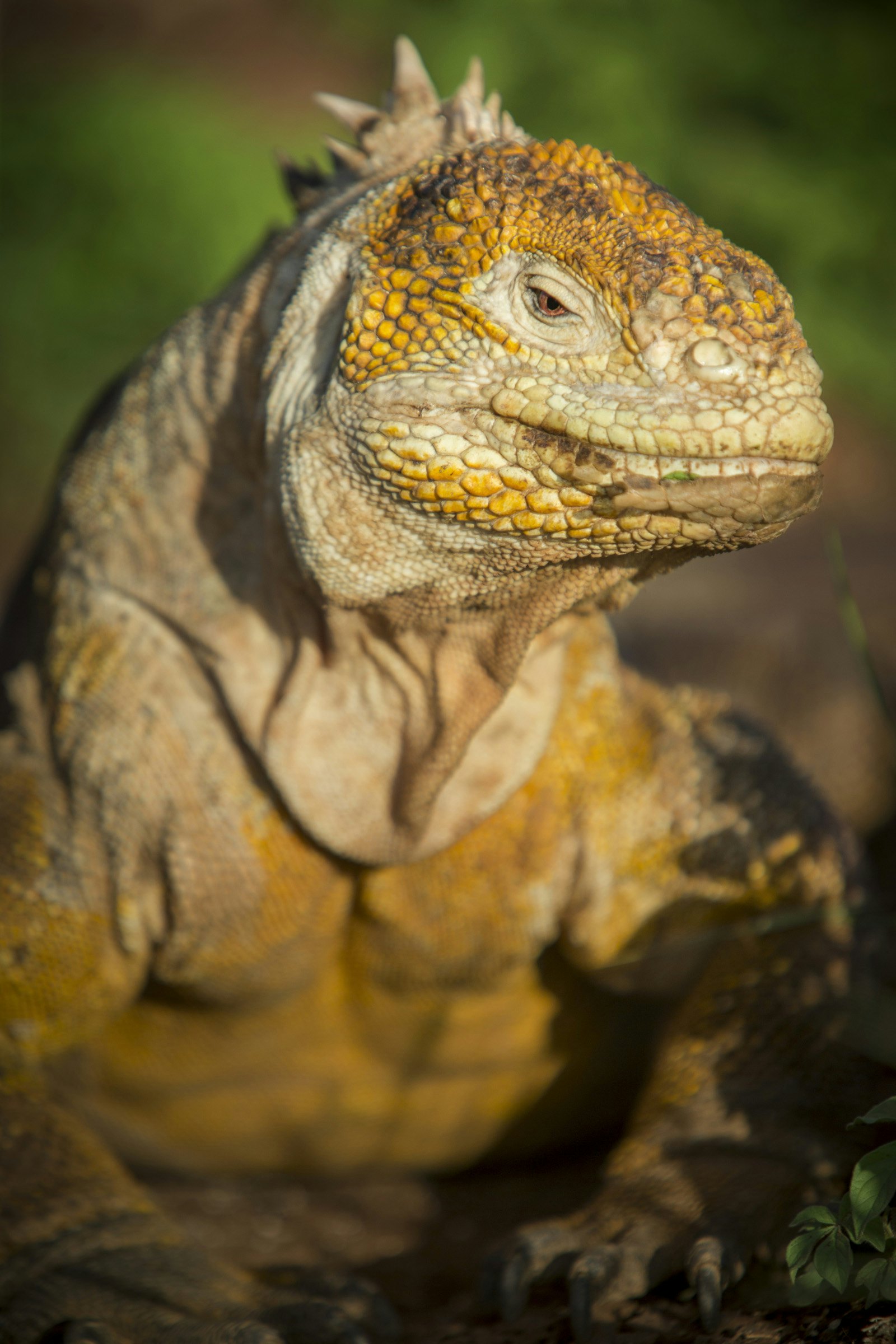
Many of the Galápagos’s classic wildlife encounters can be had on Santa Cruz rather than by swiftly embarking on a cruise, as most visitors do. 'Everybody is happy now, there is so much food,' says Ramiro Jácome Baño, a naturalist guide officially sanctioned by the Galápagos National Park. This is the hot and wet season, a time of plenty. Baño points to the thickets of herbs that have sprouted around Cerro Dragón, a fanglike volcanic peak that rises from ancient lava flows on the northwestern tip of Santa Cruz. 'Stop!' he warns dramatically as a male land iguana swaggers onto the path ahead, with resplendent yellow skin. The endemic land iguanas and marine iguanas of the Galápagos are believed to have shared ancestors that landed here after a great sea journey. 'They have evolved from the green iguanas you will find on the Ecuadorian mainland,' says Baño. 'These will either have swum all the way across, or more likely drifted over on vegetation.'
At the Charles Darwin Research Station on Santa Cruz, a conservation success story is playing out. More than 3000 giant tortoises have been raised from hatchlings to a size where they can resist attack from invasive species such as cats, pigs or dogs introduced by passing mariners. The adolescent tortoises are released into the wild, and can live to an age of 200. Today, in the noon heat, they lounge like majestic boulders in the El Chato Tortoise Reserve’s mud pools. Creatures with faster-paced lives bustle about them: Darwin’s finches, displaying to one another, as short-eared owls keep watch from above.

The diverse birdlife of Santa Cruz also can be observed at the Finch Bay Eco Hotel, a brief taxi boat ride from Puerto Ayora. Guests share the open-air bar with Galápagos mockingbirds hunting tiny geckos, and the pool with a family of white-cheeked pintail ducks. Puerto Ayora’s beach lies just beyond; there, locals cool down by splashing on inflatable floats, or attach snorkels to search for creatures every bit as remarkable as the land-based wildlife. Within a short paddle, a Pacific green sea turtle can be seen grazing on algae, and a trio of eagle rays glide in perfect formation.
The sea life of the Galápagos still surprises Baño, 20 years into his time as a park guide. 'Recently I was approached by a manta ray,' he says. 'She had some fishing net caught around her horns. She allowed me to lift it off, before disappearing into the deep.'
Peter Grunert traveled to Ecuador with support from Cox & Kings. Lonely Planet contributors do not accept freebies in exchange for positive coverage.
https://shop.lonelyplanet.com/products/lonely-planets-best-in-travel-paperback-2019








